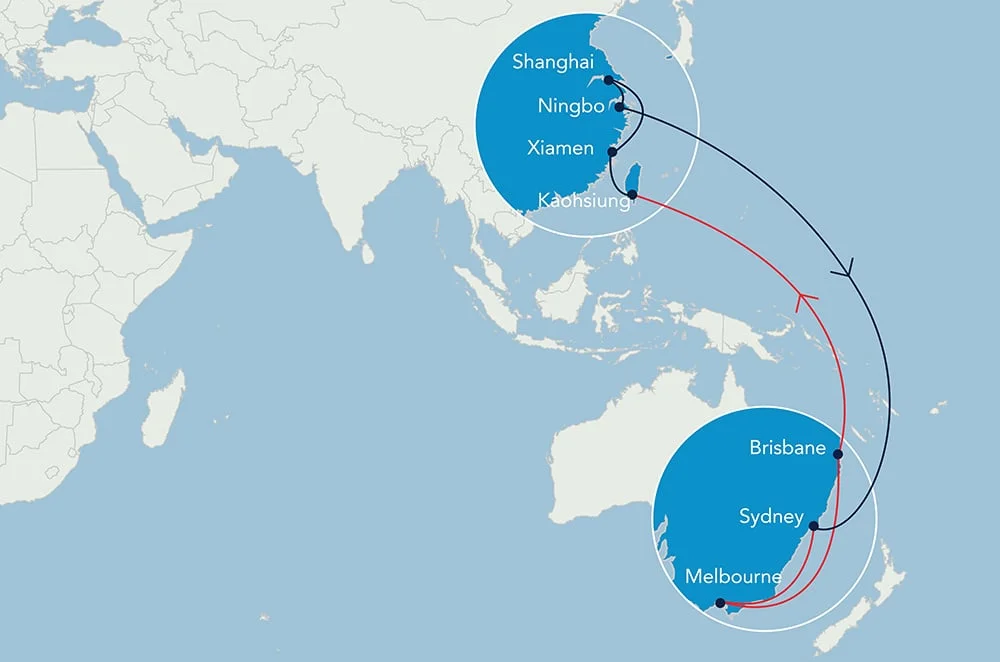- 19 June 2025
Behind the Scenes of Vessel Delays
As international trade grows and globalisation accelerates, vessel delays have become a persistent challenge rippling across the entire supply chain. These delays don’t just impact a single shipment; they trigger a snowball effect, causing widespread disruptions that affect manufacturers, distributors, and ultimately, end consumers.
So, what’s really behind these delays?
The Port Call Domino Effect
Container vessels operate on fixed rotation schedules, stopping at multiple ports along their journey to load and unload cargo. A delay at any port, whether due to congestion, slow handling times or adverse weather, can disrupt this tightly coordinated schedule.
As shown in the below port call map, a typical vessel traveling between Asia and Australia follows an extensive route. When one port experiences a delay, the vessel may miss its scheduled berthing window at the next destination, requiring it to anchor and wait. This creates a cascading effect, with delays rippling through subsequent ports and impacting the entire shipping network.

How Delays Snowball
Imagine a vessel traveling from Shanghai, China, to Melbourne, Australia. If it departs Shanghai later than planned (due to weather, customs delays or port congestion) it arrives late in Ningbo, missing its allocated slot. This initial delay sets off a chain reaction, where the vessel then arrives late at Sydney, Brisbane and finally Melbourne.
With port calls carefully timed and minimal buffer room in the schedule, even a minor delay can snowball into significant disruptions. Picture this: shipments meant to flow seamlessly are now held up, throwing supply chains into disarray, especially for businesses depending on just-in-time delivery. The ripple effect touches every link in the chain, from manufacturers waiting on raw materials to consumers anticipating finished products.
Key Factors Driving the Delays
-
Port Congestion: Many ports are still grappling with congestion due to a mix of high container volumes, limited labour and infrastructure constraints. A single backlog can take days or even weeks to clear.
-
Weather Conditions: Seasonal storms in the Asia-Pacific region frequently impact sailings.
-
Equipment Shortages: A lack of critical handling equipment such as cranes or empty containers slows down port operations, contributing to longer stay times for vessels.
-
Customs & Regulatory Delays: Stricter border checks, customs delays, or documentation issues can also add unexpected time at port.
-
Labor Shortages & Strikes: Industrial actions or staffing shortages especially in key global ports can severely disrupt port operations, leading to extended vessel waiting times.
Why It Matters for Supply Chains
-
Longer Lead Times
-
Higher Inventory Holding Costs
-
Production and Sales Disruptions
-
Strain on Warehousing and Domestic Transport
-
For businesses relying on consistent and timely shipping from Asia to Australia, these disruptions translate to uncertainty and increased cost.
Navigating the Uncertainty
To mitigate these risks, many businesses are diversifying their shipping routes, extending lead times, and collaborating closely with logistics partners to monitor and adapt to changes in real time.
Understanding the interconnected nature of vessel movements and the vulnerabilities within the port network is critical. That’s where Mainfreight comes in. With our expertise, we provide full visibility of your shipments, ensuring you have the insights needed to make proactive decisions. By leveraging real-time data and advanced planning, Mainfreight helps you stay ahead, even when vessels fall behind, keeping your supply chain resilient and reliable.
Smart, Flexible Ocean Freight
Our sea freight service offers the perfect balance of cost efficiency and flexibility. From smaller consolidated LCL (Less than Container Load) shipments to full FCL (Full Container Load) moves, we connect you to all major trading hubs. Our expert team ensures your cargo arrives exactly where it needs to be, when it should
Find out more here